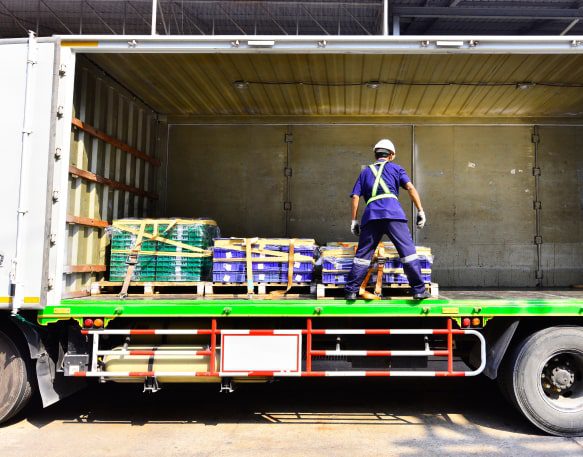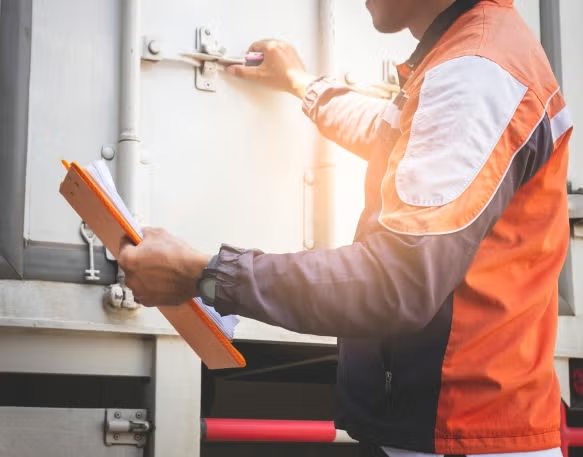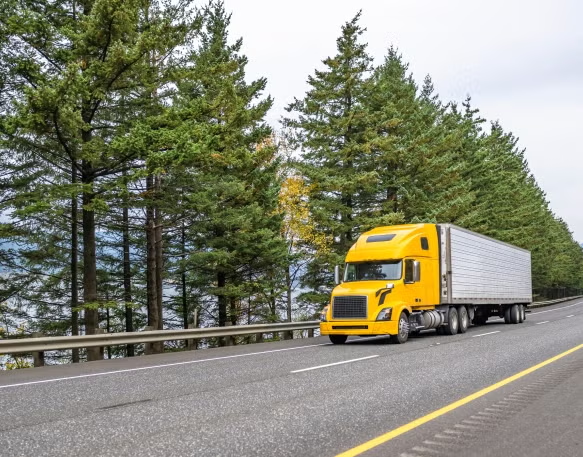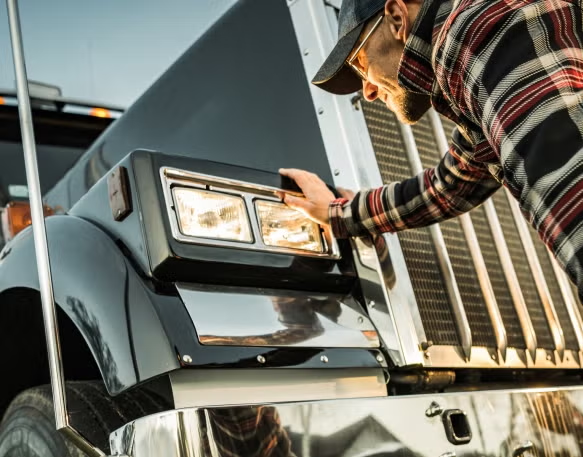As a truck driver, you need to keep track of many things when you’re picking up, transporting, and delivering loads. Not only do you need to navigate your way to your next dropoff location and stay focused for hours at a time, but you’ll also need to pay attention to fuel prices, handle potentially dangerous road conditions, practice defensive driving, and stop at weigh stations along the way.
You’ll also need to use cargo securement devices to ensure your loads won’t shift or fall out during your journey. Unfortunately, many people overlook the importance of load securement. Instead of investing in quality cargo securement devices and taking the time to secure loads before each trip, they just throw everything in the back of the truck and hope for the best.
Neglecting proper cargo securement is both incredibly irresponsible and highly dangerous for yourself, your cargo, other drivers, and the workers who will eventually unload your load.
The importance of securing freight
Properly securing freight should be a top priority for any operator. It’s not just good for business, it’s good for everyone on the road. If a piece of cargo isn’t adequately secured and suddenly falls off your truck, someone could get hurt or killed, whether they run into it or swerve to avoid it. And if you believe this can’t happen to you, think again.
Over 200,000 crashes were caused by debris on U.S. roads between 2011 and 2014 alone. 39,000 people were injured and more than 500 people were killed in that same period due to debris — and around two-thirds of these crashes were the result of cargo falling from vehicles.
However, cargo doesn’t even need to leave the vehicle to put you and your fellow drivers in harm’s way and cause severe damage. If your cargo shifts mid-route due to a bump, sharp turn, or sudden stop, it will instantly change your trailer’s weight distribution, which could cause you to lose control over your trailer and spin out of control. You might side-swipe a nearby car, or your trailer might flip!
If the idea of protecting your cargo, yourself, and your fellow drivers on the road isn’t enough to convince you to take the time to carefully secure your cargo before each journey, remember that improperly securing loads means more expenses. Without proper cargo securement, you’re a liability. Your insurance rate may skyrocket to staggering heights, which could cut into your company’s overall profit margin. Worse still, if an accident occurs and people are injured, you could be sued or fined and sent to jail for reckless endangerment.
And that’s still not all. Finding the perfect load only gets you so far if you don’t secure your freight and end up losing or damaging goods en route. In addition to impacting your pay, that can also have long-term negative effects on your working relationship with that particular company. If you develop a reputation for losing or damaging cargo, you’ll quickly become the last person companies want to work with, putting your business in hot water down the line and even potentially leaving you without a job.
What’s more, violating federal and state load securement regulations could mean paying thousands of dollars in fines for non-compliance. Clearly setting aside a few minutes for load securement before every trip should be non-negotiable.
Federal regulations
More than just being the decent thing to do, load securement is the legal thing to do. The Federal Motor Carrier Safety Administration (FMCSA) requires that truck drivers inspect and secure their cargo before starting their vehicle. You should also review the cargo itself regularly. Within the first fifty miles of a trip, you’ll need to check your load to ensure that nothing has shifted. Plus, you should double check your cargo when changing duty status, after driving for three hours, or after driving 150 miles to comply with the FMCSA’s requirements.
To meet regulations, cargo securement systems need to be capable of withstanding 0.8 gravity (g) deceleration in the forward direction, 0.5 g acceleration in the rearward direction, and 0.5 g acceleration in the lateral direction. Of course, carriers don’t have to actually test their load securement systems to see if they meet performance requirements. Instead, any cargo secured per the FMCSA’s general securement or commodity-specific rules is considered to meet performance criteria. That means having strong vehicles, systems, and parts in working order and using tie downs that are correctly attached and secured. For trailers with rub rails, tie downs should be located inboard of the rub rails when possible. If a tie down will be subjected to abrasion or cutting where it touches cargo, abrasion-, crushing-, and cutting-resistant edge protection must be used.
Generally speaking, all cargo needs to be firmly secured or immobilized with shoring bars, tie downs, dunnage, dunnage bags, or some combination. Any objects that may roll will need to be restrained using a cradle, wedges, or chocks, and any items placed beside each other and secured with transverse tie downs will need to be either placed in direct contact with one another or secured in such a way that they won’t shift towards each other throughout the journey.
Additionally, your load securement system will need to have a minimum aggregate working load that’s at least half the weight of the cargo it’s securing, and you’ll need to have a certain number of tie downs to meet requirements. If you’re transporting objects shorter than five feet in length or weighing less than 1,100 lbs, you can get away with one tie down. However, you’ll need two tie downs for articles that are longer than five feet or weigh more than 1,100 lbs. If you have an item that isn’t blocked, may move forward, and is longer than ten feet, you’ll need to use two tie downs for the first ten feet of length and an additional tie down for every additional ten feet.
In addition to these general regulations, FMCSA also includes detailed load securement requirements for transporting many specific commodities, including logs, metal coils, paper rolls, concrete pipes, heavy vehicles, equipment, and machinery, flattened or crushed vehicles, automobiles, light trucks, and vans, large boulders, dressed lumber, intermodal containers, and roll-on/roll-off or hook-lift containers.
It’s true that there are a lot of federal regulations to keep track of, but it’s important that you do. Otherwise you may face steep fees and receive lower Compliance, Safety, Accountability scores if you’re caught violating any rules.
The basics of tie down ratings
Tie downs are popular load securement tools that prevent shifting and ejection, so you won’t lose any goods mid-journey. They can also protect you from liability and are ideal for large and bulky cargo, such as lumber, furniture, and appliances. However, not all tie downs are created equal and you’ll need to have the appropriate ones to ensure safety and compliance.
Each strap is rated for a working load limit (WLL), or the maximum safe working load limit, and the combined rating of all straps needs to be equal to or greater than half the load’s total weight. For example, if you’re hauling a 30,000-pound load, your tie downs will need a combined working load limit of at least 15,000 pounds. However, straps without clear labeling can be downgraded based on type and size (and given a rating of zero if in Canada!), so it’s always better to have more tie downs than necessary rather than too few.
Straps are also rated based on their maximum load (or the amount of weight that causes strap failure). Typically, a strap’s maximum load is three times its WLL.
It’s also worth noting that you’ll need an appropriately long tie down strap for successful flatbed load securement or truck load securement. Tie down straps that are too short won’t secure your cargo, but ones that are excessively long mean loose ends that could quickly get in the way.
Placing straps
Whether you’re trying to achieve proper flatbed load securement or truck load securement, where you place your straps is just as important as which ones you use. Straps in the right place will keep your cargo secure, but straps in the wrong place can result in loose cargo. It’s always best to use straps in pairs, but there are some more specific recommendations, depending on your vehicle and cargo.
For flatbed load securement in trailers without header boards and for lighter cargo, you’ll need to place two straps in the first ten feet of cargo and then another for every ten feet. This is because the weight and friction will work to keep both loads in place. However, if you have two stacks of cargo that aren’t butted together, both stacks will need two straps initially (and other straps as necessary).
However, load securement for vans and reefers looks a little different. General cargo will need to be braced, blocked, placed on friction mats, or packed with void fillers if your trailer isn’t loaded from wall to wall. Plus, there are specific load securement requirements for things like metal coils, rolled paper, and hazardous materials. Since some vans’ walls flex, you may need to invest in logistics tracks to ensure your load-lock poles don’t lose their grip and cause your precious cargo to fall or shift when the walls shift.
Thrive with DAT
Proper load securement techniques and cargo securement devices are essential to any trucking operation. Failing to adhere to load securement regulations could mean lost cargo, accidents, injuries, lawsuits, or even death — not to mention increased insurance rates and a poor reputation among companies.
However, there’s much more to being a carrier than truck load securement. You’ll need to find loads, plan cost-efficient routes, negotiate with brokers or shippers, and much more. If you need some help, check out DAT’s carrier fleet services. You’ll have your choice of over 644,500 new daily loads and access to current lane rates, so booking and negotiating will be a breeze. You can even take advantage of our fuel card or factoring partnership programs to keep your cash flow under control.
Whether you’re a new carrier or have decades of experience under your belt, DAT and our carrier fleet services can help you grow your business. Get started with DAT today!
Help your business thrive with DAT’s carrier fleet services!
Being a carrier goes beyond proper load securement. You also need to find loads, buy fuel, determine efficient routes, and manage your cash flow. It can get overwhelming quickly, but DAT’s carrier fleet services can make everything infinitely easier! Explore our plans today!




